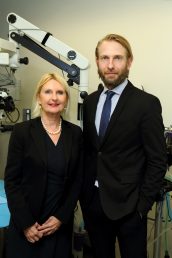UIC researchers launch company to develop ‘chimeric cell’ therapy for Duchenne muscular dystrophy
Two University of Illinois at Chicago orthopedic surgeons have launched a new company that will develop a unique cell-based therapy for the treatment of a rare but deadly form of muscular dystrophy called Duchenne muscular dystrophy.
Dr. Maria Siemionow, professor of orthopedic surgery, and her son, Dr. Kris Siemionow, associate professor of orthopedic surgery in the UIC College of Medicine, are the co-founders of Dystrogen Therapeutics SA.
Duchenne muscular dystrophy is an X-linked genetic disorder characterized by progressive muscle degeneration and weakness, affecting approximately 1 in 4,000 newborn boys.
People with Duchenne muscular dystrophy don’t have the gene for dystrophin, a structural protein that helps keep muscle cells intact. Symptom onset is in early childhood, usually between ages 3 and 5. The disorder causes muscle weakness and loss of motor function and ultimately results in respiratory or cardiac failure and death. With advances in treatment, many with Duchenne muscular dystrophy live into their teens and 20s, and some into their 30s, but there currently is no cure for the disease.
Promising treatments include gene therapy and stem cell therapy, but each have their drawbacks. Gene therapy relies on delivering good copies of missing or dysfunctional genes to cells via viruses. Not only can cells become immune to viral infection, rendering the therapy ineffective, but there also is no guarantee that viruses will only infect the intended cells. Stem cell therapy, where cells that contain the dystrophin gene are implanted into a recipient, require that the recipient take immunosuppressive drugs to prevent rejection.
Dystrogen Therapeutics will advance the use of blended cells called “chimeric cells” to treat Duchenne muscular dystrophy.
“The idea is to create a cell that contains the dystrophin protein, which is lacking in the recipient,” said Dr. Maria Siemionow.
“If a donor cell that can produce dystrophin is taken from a close relative of the recipient — in the case of Duchenne the donor is usually the father — and fused with a cell from the recipient, the resultant chimeric cell is less likely to be rejected by the recipient because it contains self markers and closely related markers,” said Siemionow. “These chimeric cells can do a much better job of evading their host’s immune system than traditional donor cells, and can reduce or even eliminate the need for the recipient to take immunosuppressive drugs to prevent rejection.”
In a January 2018 paper in Stem Cell Reviews and Reports, Maria and Kris Siemionow and colleagues reported that when chimeric mouse cells made by fusing a cell that produces dystrophin with one lacking dystrophin were implanted into a mouse model of Duchenne muscular dystrophy, levels of dystrophin in the muscles rose by about 35 percent. The new cells were composed of both donor and recipient structures and interacted with their surroundings like normal cells. The chimeric cells remained viable and produced dystrophin for 30 days. Mice whose muscles were injected with chimeric cells performed better on muscle function tests.
“The use of chimeric cells represents a truly unique approach to delivering a needed protein while avoiding problems associated with other therapeutic methods,” said Dr. Kris Siemionow. “Only a 20 percent increase in dystrophin levels is needed to significantly reduce many of the symptoms associated with Duchene muscular dystrophy, and in our mouse models, we are able to boost production to 35 percent,” he said. “We are very enthusiastic about our treatment, and are looking forward to continued successful studies and hopefully pre-clinical trials in the near future.”

